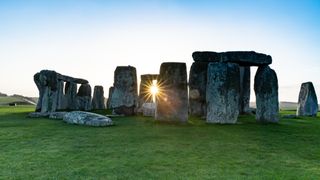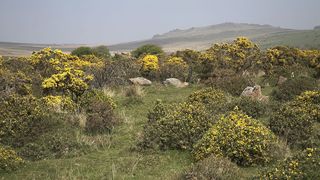100-year-old origin theory of Stonehenge's iconic Altar Stone could be wrong, scientists say
A new analysis of the Altar Stone at Stonehenge suggests it may have come from as far north as Scotland, allowing for "creative thinking" about its archaeological significance.

The largest stone in Stonehenge's inner circle, known as the Altar Stone, may have come from farther afield than its neighboring monoliths — possibly even from northern England or Scotland, according to a new study that questions a 100-year-old idea about the stone's origins.
A century has passed since British geologist Herbert Henry Thomas published his seminal 1923 study on Stonehenge, in which he traced the origin of the "bluestones" that make up the monument's inner circle to the Preseli Hills in western Wales. Among these bluestones — so called because they acquire a bluish tinge when wet or freshly broken and to distinguish them from the "sarsen" stones that make up the outer circle — Thomas included a 16-foot-long (4.9 meters) flat-lying, gray-green slab of stone known as the Altar Stone.
"It seems as though he wanted all the non-sarsen stones to come from a limited geographic area and this basic assertion has not been challenged for 100 years," Richard Bevins, an honorary professor of geology and Earth sciences at Aberystwyth University in Wales who led the new research, told Live Science in an email.
It now appears that Thomas' assessment was flawed, Bevins and his colleagues have found in a new study, published in the October issue of the Journal of Archaeological Science: Reports. While Thomas "quite rightly" pinpointed the source of some stones to outcrops in western Wales, the Altar Stone likely came from a completely different location, possibly an unknown quarry in northern Britain, Bevins said.
Related: Was Stonehenge an ancient calendar? A new study says no.
Stonehenge was erected during Britain's Late Neolithic period, roughly 4,000 to 5,000 years ago, on Salisbury Plain in Wiltshire, in southern England. The monument was built, rebuilt and added to over thousands of years, with the bluestones brought to the site during an early construction phase.

Early excavators of Stonehenge called the bluestones "foreign stones," because they are exotic to the Wiltshire landscape. Their long-haul transport over 140 miles (225 kilometers) from western Wales to Stonehenge is one of the farthest known distances from a source to a prehistoric monument construction site anywhere in the world, according to the study.
Sign up for the Live Science daily newsletter now
Get the world’s most fascinating discoveries delivered straight to your inbox.
The Altar Stone has always stood out from the other bluestones because it's much larger and made of a different type of rock, Bevins said. There is also "no archaeological evidence as to when the Altar Stone arrived at Stonehenge," he added, raising the possibility that it could have been brought to the site during a later construction phase.
To shed light on the stone's origin, the researchers compared its geochemistry and mineralogy with 58 sandstone outcrops stretching from southern Wales to western England. But the search "failed to make a match," Bevins said, and the researchers concluded that they might be looking in the wrong place.
The Altar Stone displays an unusually high amount of the chemical element barium, which has helped the researchers narrow down further potential sources.
"Initially, we feel it appropriate to investigate areas where there are known ancient monuments of Neolithic ages," Bevins said. These areas stretch across northern England and Scotland, broadening the horizons of a search that has so far focused exclusively on Wales and allowing for "creative thinking about the source of the Altar Stone," he said.
The characterization of the Altar Stone as a bluestone is now up for debate, Bevins added, rewriting its archaeological significance in the history of Stonehenge.
This isn't the first time Bevins and colleagues have challenged Thomas' century-old work. In 2018, they reported in the journal Antiquity that the bluestones came from a completely different outcrop of rocks at Preseli Hills than Thomas suspected.

Sascha is a U.K.-based trainee staff writer at Live Science. She holds a bachelor’s degree in biology from the University of Southampton in England and a master’s degree in science communication from Imperial College London. Her work has appeared in The Guardian and the health website Zoe. Besides writing, she enjoys playing tennis, bread-making and browsing second-hand shops for hidden gems.
-
Giovani Reply
Just curious. At one time the stones were all positioned and forming a basically level top surface all around, as if something was to rest upon these massive slabs of stone. Something very heavy.admin said:A new analysis of the Altar Stone at Stonehenge suggests it may have come from as far north as Scotland, allowing for "creative thinking" about its archaeological significance.
100-year-old origin theory of Stonehenge's iconic Altar Stone could be wrong, scientists say : Read more
Have any tests been done from samples of these cap stones top surfaces? Perhaps the truth is stranger than fiction here. I think maybe more information is needed, which is forthcoming, I'm sure.
As discoveries are added to this mystery, it deepens my increasing amateur imagination when wondering if this structure was purposely built for a specific reason, and not a religious one. -
bryn67 You have the circles mixed up... The Bluestones are the (relatively) lighter weight, OUTER circle that came from Wales...I quote ." used to refer to the smaller stones at Stonehenge. These are of varied geology but all came from the Preseli Hills in south-west Wales. Although they may not appear blue, they do have a bluish tinge when freshly broken or when wet. They weigh between 2 and 5 tons each."Reply
Most Popular


